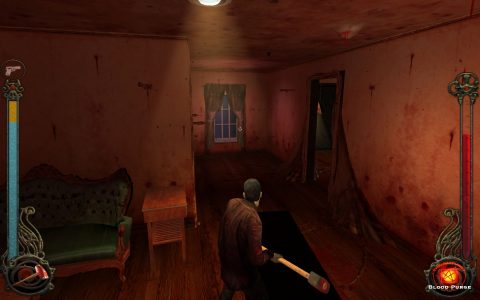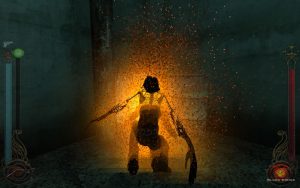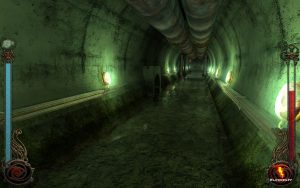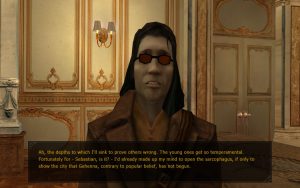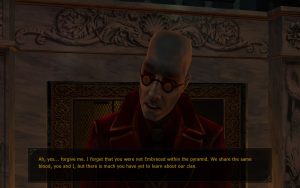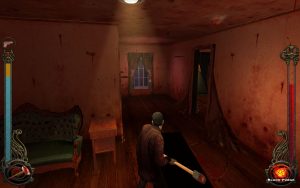- Vampire: The Masquerade (Introduction)
- Vampire: The Masquerade – Redemption
- Vampire: The Masquerade – Bloodlines
The name “Troika” might bring memories for Western RPG fans. Founded by the creators of Fallout (Tim Cain, Leonard Boyarsky and Jason D. Anderson), this iconic studio is still revered for three cult-classic games: Arcanum, The Temple of Elemental Evil and Vampire: Bloodlines. Specializing in non-linear gameplay and brilliant writing, the studio seemed like the ideal match for the Vampire tabletop license. Unfortunately, it was Activision which acted as the middle man on this pairing, which resulted in massive development troubles and an unfinished game. But in spite of its issues, it still turned out pretty well.
Bloodlines puts you in the shoes of a poor sod embraced during the introduction cutscene. Since the local Prince didn’t give his permission to your embrace, your sire is executed and you’re soon to follow. An Anarch leader intervenes on your behalf, leaving you wandering in the dark streets of Los Angeles. Of course, Prince La Croix don’t let you go that easily and demand various tasks through the game.
The plot of Bloodlines revolves around two main events: the ongoing war for the Free Anarch States of L.A and the discovery of an ancient sarcophagus. For years, the City of Angels was akin to an Anarchic domain were vampires could escape the Jyhad and elder vampires’ plot, hence the “Free Anarch States”. In the late 1990s, Kuei-jin (Asian vampires) started a bloody skirmish for the control of the city. Seeing the Anarchs weakened, the Camarilla and the Sabbat sent their own representatives in order to gain a new foothold in California. In a nutshell, everything is awful, and the arrival of an ancient sarcophagus, shrouded in blood and mystery, is going to make things worse. Does it contain a sleeping elder? Or even an Antediluvian No one knows, but LaCroix wants it, badly. Like Bogart in The Maltese Falcon, you will be running after this Macguffin for most of the game while L.A power players manipulate you at every turn.
Here are some of the major NPCs you will encounter:
Prince Sébastien La Croix
A French Ventrue embraced during the 19th century. He tries to prove his valor to the Inner Circle by adding Los Angeles to the list of Camarilla-controlled cities. He also “spares” your life at the beginning of the game in exchange for some small favors. Obsessed by the Ankaran sarcophagus, he goes to great lengths and shady alliances to get it. La Croix acts as your direct superior during most of the game. Thanks to his Domination discipline, you won’t have much say in the matter. He is pretty much your usual Ventrue – power-hungry, well-spoken and strongly protected. He is always escorted by the Sheriff, a scary giant with a huge sword.
Nines Rodriguez
The Brujah who probably saved your undead skin. Nines is the unwilling leader of the Anarchs of Los Angeles. Embraced during the Great Depression, he is a tough as nails individualist and strongly opposes the factions trying to capture his city. He acts as an adviser towards the player, doling out advice and training in combat skills.
Beckett
Beckett isn’t a Los Angeles resident, so he is probably the only person you can trust. A Noddist, Beckett tries to understand the reason for Kindred existence and their beliefs, such as Gehenna or Cain. As an archeologist, he will give you precious information on the Ankaran sarcophagus. Note that Beckett used to be THE recurring character in numerous White Wolf novels. He hides his glowing eyes, a Gangrel stigmata, behind tinted shades.
Jeannette Voerman
The lovely lady on the box art. She resides in the Asylum club in Santa Monica with her sister Theresa, the Baron of Santa Monica. The siblings have a strained relationship you will need to fix, one way or another, if you want to enjoy the rest of your nights.
Smiling Jack
A pirate roaming the Caribbean sea in the 17th century, Jack is now one of the very few elder Anarchs. For this reason, most of the L.A Anarchs see him as a local legend. He acts as your mentor in the tutorial, showing you the ropes of unlife and a crash-course on politics. Later on, he can share advice if you stop by the Last Round in Downtown.
For starters,Bloodlines makes you create your own character through a virtual copy of the tabletop character sheet. Character creation is a lite version of the original material. The idea is to spend points between your nine attributes divided in three rows (Physical, Social and Mental) and your abilities to strengthen specific actions. Attributes are much more expensive since they affect multiple skills at once. Raising Dexterity makes you a better marksman and a nimbler thief. Abilities are cheaper but affect only one aspect of the character: seduction, melee, dodge, finance, and so forth. The game mechanics makes dice checks for combat (shooting, dodging, etc) but skills use fixed difficulties. You can also choose your sex, opening some specific lines for dialogues and seduction skill. Last but not least, disciplines are your vampiric powers. For obvious reasons, they cost quite a lot.
The most important choice from the get-go is your clan. Any Camarilla clan can be picked: Brujah, Ventrue, Gangrel, Nosferatu, Tremere, Toreador or even the crazy Malkavian. Each clan gives you access to three disciplines and a specific double-edged trait. For example, due to their short fuse, Frenzy checks are harder to resist for Brujah but they also get initial bonus to combat skills. Troika had the smart idea to tweak the trio of disciplines restricted to each clan from the core rules. Therefore, each discipline allows you to handle every encounter differently: mental control, superhuman strength or invisibility.
While most of the clans play the same way, Malkavians and Nosferatu deserve a special mention. Playing as the former turns dialogue options into eerie prophecies and ramblings and makes ethereal voices to whisper dangerous advice. Nosferatu can’t socialize much since they look exactly like Murnau’s monster, forcing you to stride through sewers and back alleys. Both options are incredibly fun and only scratch the surface in terms of Bloodlines‘ content and replayability.
The controls and user interface are pretty straight-forward. Using an early version of Valve’s Source engine, Bloodlines plays like an FPS most of the time. By drawing a melee weapon, the game switches to a particularly buggy third person camera. Mouse-clicking triggers attacks and disciplines, while the traditional WASD keys are used for direction. Like in Half-Life, weapons, armor and such are selected with the function keys, but a traditional inventory is also available. ‘E’ is used to interact with the world around you while ‘F’ allows you to feed. There are two bars to manage, your health and your blood. Note that contrary to Redemption, healing is passive and can only be boosted by feeding on someone or taking painkillers. Feeding leaves you wide open and can endanger the Masquerade if you are in a city hub.
Melee combat is pretty simple, offering four different combo attacks (one for each directional key) and a parry button. Animations are incredibly stiff and the lack of inertia makes fights look pretty goofy. Damage and defense are, as usual, mostly based on your character’s stats and weapons. Modifiers can be pretty important, so don’t bother using a powerful weapon if your stats are too low. To cope with each style of play, your character possesses the universal discipline called a “blood buff”, which raises all your physical skills up to 5 for a short time. Ranged combat works pretty much the same way, except for the first-person view. Like every FPS-RPG, using a pistol at point-blank range and missing is infuriating as hell but that’s the rule. In a nutshell, combat mechanics don’t really feel interesting nor rewarding. Using stealth or abusing disciplines is much more fun.
Like Redemption, Bloodlines takes great care to use the mechanics dedicated to Kindred. The vampiric disciplines are probably the best aspect of combat and a fine complement to stealth sequences. Need to become invisible? Use Obfuscate. Want to kill someone without dirtying your hands? Use Dominate and the poor guy will commit suicide. Most powers are unique and offer a real sense of satisfaction to use. Contrary to the other V:TM game, their number is reduced but each level invested usually give you access to a new power. Be careful not to use them too much in a row, otherwise you will dry up your blood pool. The only real drawback is that some of the powers (Dominate and Dementation in particular) feel too similar, but that’s an unavoidable drawback for a video game.
The level-design is very reminiscent of Deus Ex. Each mission is located in a large closed space (inside or outside Los Angeles’s hubs) with security systems, guards routines, computers and alternative routes. You can tackle those missions in any way you like, but discretion and non-lethal runs are advised for maximum experience points. Pressing ‘Ctrl’ activates stealth mode, allowing you to become invisible to guards if you stay in the shadows and far from their sight. Taken aback, enemies can be stealth killed with a melee weapon or drained from their blood easily. As your stealth skill progresses, the system gets wonkier and guards become completely blind to you. Hacking computers and lockpicking doors is a good way to breeze through levels since it gives you access to passwords and various objectives extremely fast. A less subtle approach is always possible since guards leave their keys everywhere.
There is also a morality system in Bloodlines. You start with a Humanity rating of 7 (out of 10) and moral actions influence it. Killing innocents or accomplishing infamous acts will reduce it while good deeds raise it. There are only two real consequences related to Humanity. The most obvious one is that the lower it gets, the more often you’ll enter Frenzy. It’s a bitch, and you lose the control of your character. The other is the change of dialogues lines, reflecting your new inhumane attitude. Humanity is rewarded all the time, so don’t bother spending experience points in it.
Maintaining the Masquerade is a much bigger deal. You can break it up to five times until getting a game over. Zones are divided in three types, each allowing a different scale of freedom. In Elysiums (vampire havens), you can’t use weapons nor disciplines, even subtle ones. In Masquerade zones like the main hubs, you are free to use either of them but shooting people will attract human law enforcement while displaying vampiric powers or careless feeding will break the Masquerade. Rats and blood packs can also be used in case of need. Main missions usually take place in combat zones where you can do whatever you want.
Los Angeles is divided into four different hubs: Santa Monica, Downtown, Hollywood and Chinatown. With the Ankaran sarcophagus plot looming in the background, the main missions revolves around accomplishing favors for each area Baron (the Anarch “prince”). Missions objectives varies heavily from exorcizing a ghost house to breaking in a museum. The four hubs are loaded with sidequests, encouraging you to sweep every inch of those places. Each district offers a very different feeling and atmosphere, thanks to the never disappointing architecture design and the top-notch music. The grim sonorities composed by Rik Schaffer immerse you into the shady streets of Los Angeles. Fans of death metal and gothic rock will also have a run for their money since Troika used a lot of licensed music to breathe life into the various night-clubs (like Lacuna Coil and Tiamat).
Lore-wise, Troika succeeded in mixing a general framework for neophytes with obscure details about the World of Darkness. By the end of the game, new players will despise Ventrues, fear werewolves and be disgusted by Kindred politics. Seasoned pen and paper players might be surprised to encounter lesser known vampiric bloodlines and other things from forgotten sourcebooks. With this level of detail and the depth of the story, it’s a fantastic achievement.
The biggest problem of Bloodlines is that the more you progress, the less the gameplay becomes bearable. Mission zones slowly turn into hack and slash dungeons, giving you no other alternatives than fighting your way through dozens of enemies in extremely small corridors and bland environments (sewers, shady hotels, underground bases). Even worse, the final mission compels you to choose a faction to complete the game and kill one of the main antagonists of the game. The two finals dungeons are a pain in the ass to go through, both ending with a tough-as-nails unskippable boss fight. If your character don’t have some good stats in combat skills, the whole thing can turn pretty sour fast.
While Bloodlines‘ action starts to get pretty bad later on (circa late Hollywood), writing never, ever disappoints. It has always been Troika’s strong suit and their final game is no exception. The complex setting of political intrigue is extremely well explained, each major NPC has a unique personality and you character’s tone always hits the soft spot between rightful indignation and grim humor. The facial animations are surprisingly expressive for a game made in 2002. The voice acting is outstanding Most of the actors will be extremely familiar to video game players (Micheal Gough, Grey Delise, John DiMaggio) but the delivery and the direction really make them unique. Some quests can be resolve through persuasion or fast talk. New options appear according to your skills a la Fallout : New Vegas. You can persuade, intimidate or seduce your way through many dialogues. Be aware, though, that the developers do not pull any punches when it comes to consequences. Select a blunt answer, and just like that, you might botch a ongoing mission, earning you penalties and no experience points at all. So save often.
Being the first third party game to use the Source engine, unfortunately development was pretty hectic. The game was unfinished and Activision had already cut the funds a few months before the launch. If you are interested in more details, you might want to check the book Gamers at Work where Tim Cain explains the insane production cycle of the last Troika creation. Thanks to the legion of bugs and crashes, playing the game around the time of release was difficult, finishing it almost impossible. Fortunately, current players can use the amazing work of WASP 5, a loyal fan who has been patching the game for years. Don’t forget to install the high resolution patch and the 4GB patch, otherwise the game is unplayable on Windows 7/8. It’s also a good idea to activate the console, just in case.
Bloodlines is a must in term of atmosphere, even for hardcore tabletop veteran. It’s brilliantly written and should be played by any WPRG fan but it also becomes more and more tedious as the game progresses with unfinished areas and weaker level-design. The fan-patch corrects many things, but the game remains a slightly broken masterpiece.
Links:
WASP’s unofficial patches Those fan made patches are required to make the game running and winnable.
Reanimated Eurogamer’s postmortem on Bloodlines, partially based on interviews with Brian Mitsoda.










